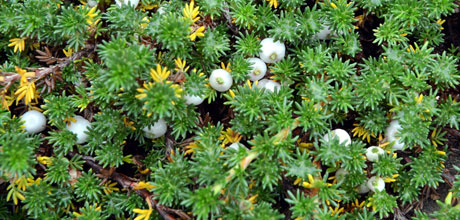Mountain Dweller Makes a Handy Groundcover
This article was first published on 08 May 2013.

Margyricarpus pinnatus
The Greek words margaritari (pearl) and karpos (fruit) give us both the common and botanical names for this delightful prostrate shrub.
Pearl fruit, Margyricarpus pinnatus is native to the South American Andes, and when you see the tiny spheres of white dotted in amongst the bright green foliage, it is immediately obvious why this name was chosen.
The flowers are tiny with no petals, perhaps the least showy member of the rose family. Clean white berries make up for this lack of floral display, standing out against the draping stems which are densely clothed in tiny needle like leaves. The fruit is edible, a little sweet, although somewhat flavour-less, and it would be rather time consuming to gather up a whole mouthful.
One of only four species in the genus, this evergreen groundcover grows at lower altitudes from 0-2000m up the interior valleys of the coastal mountains in the Andes Range. It copes very admirably with drought and is quite hardy, not batting an eyelid at our Dunedin winters. It will grow in sun or semi-shade, and displays itself beautifully when tumbling over rocks.
Plants have self-seeded in the rock garden at Dunedin Botanic Garden, in a harmless sort of way; they are slowly migrating along from the original planting, to where they can now be seen dotted throughout the rock garden.
Robyn Abernethy is the rock, water & alpine collection curator at the Dunedin Botanic Garden


